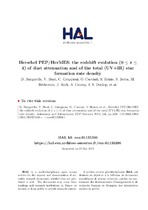| dc.contributor.author | Burgarella, D. | |
| dc.contributor.author | Buat, V. | |
| dc.contributor.author | Gruppioni, C. | |
| dc.contributor.author | Cucciati, O. | |
| dc.contributor.author | Heinis, S. | |
| dc.contributor.author | Berta, S. | |
| dc.contributor.author | Bethermin, M. | |
| dc.contributor.author | Bock, J. | |
| dc.contributor.author | Cooray, Asantha | |
| dc.contributor.author | Dunlop, J.S. | |
| dc.contributor.author | Farrah, D. | |
| dc.contributor.author | Franceschini, Alberto | |
| dc.contributor.author | Le Floch, E. | |
| dc.contributor.author | Lutz, D. | |
| dc.contributor.author | Magnelli, B. | |
| dc.contributor.author | Nordon, R. | |
| dc.contributor.author | Oliver, S.J. | |
| dc.contributor.author | Page, Matthew J. | |
| dc.contributor.author | Popesso, P. | |
| dc.contributor.author | Pozzi, F. | |
| dc.contributor.author | Riguccini, L. | |
| dc.contributor.author | Vaccari, M. | |
| dc.contributor.author | Viero, M. P. | |
| dc.date.accessioned | 2016-01-14T10:10:06Z | |
| dc.date.available | 2016-01-14T10:10:06Z | |
| dc.date.issued | 2013 | |
| dc.identifier.citation | Burgarella, D., et al., (2013). Herschel PEP/HerMES: the redshift evolution (0 ≤ z ≤ 4) of dust attenuation and of the total (UV+IR) star formation rate density*. Astronomy & Astrophysics, 554 : A70 | en_US |
| dc.identifier.issn | 0004-6361 | |
| dc.identifier.uri | http://hdl.handle.net/10566/2057 | |
| dc.description.abstract | Using new homogeneous luminosity functions (LFs) in the far-ultraviolet (FUV) from VVDS and in the far-infrared (FIR) from Herschel/PEP and Herschel/HerMES, we studied the evolution of the dust attenuation with redshift. With this information, we were able to estimate the redshift evolution of the total (FUV + FIR) star formation rate density (SFRDTOT). By integrating SFRDTOT, we followed the mass building and analyzed the redshift evolution of the stellar mass density (SMD). This article aims at providing a complete view of star formation from the local Universe to z ~ 4 and, using assumptions on earlier star formation history, compares this evolution with previously published data in an attempt to draw a homogeneous picture of the global evolution of star formation in galaxies. Our main conclusions are that: 1) the dust attenuation AFUV is found to increase from z = 0 to z ~ 1.2 and then starts to decrease until our last data point at z = 3.6; 2) the estimated SFRD confirms published results to z ~ 2. At z > 2, we observe either a plateau or a small increase up to z ~ 3 and then a likely decrease up to z = 3.6; 3) the peak of AFUV is delayed with respect to the plateau of SFRDTOT and a probable origin might be found in the evolution of the bright ends of the FUV and FIR LFs; 4) using assumptions (exponential rise and linear rise with time) for the evolution of the star formation density from z = 3.6 to zform = 10, we integrated SFRDTOT and obtained a good agreement with the published SMDs. | en_US |
| dc.language.iso | en | en_US |
| dc.publisher | EDP Sciences | en_US |
| dc.rights | This is a paper distributed under the terms of the Creative Commons Attribution License (http://creativecommons.org/licenses/by/3.0), which permits unrestricted use, distribution, and reproduction in any medium, provided the original work is properly cited. | |
| dc.source.uri | http://dx.doi.org/10.1051/0004-6361/201321651 | |
| dc.subject | Cosmology | en_US |
| dc.subject | Galaxies | en_US |
| dc.subject | Infrared | en_US |
| dc.subject | Starburst | en_US |
| dc.subject | Luminosity functions (LFs) | en_US |
| dc.subject | Far-ultraviolet (FUV) | en_US |
| dc.subject | Far-infrared (FIR) | en_US |
| dc.subject | Star formation rate density (SFRDTOT) | en_US |
| dc.subject | Stellar mass density (SMD) | en_US |
| dc.title | Herschel PEP/HerMES: the redshift evolution of dust attenuation and of the total (UV+IR) star formation rate density | en_US |
| dc.type | Article | en_US |
| dc.privacy.showsubmitter | false | |
| dc.status.ispeerreviewed | true | |
| dc.description.accreditation | Web of Science | en_US |

